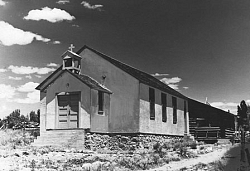Pastoral care was a struggle in the early years of Saint Joseph Parish in Monticello
Friday, Aug. 01, 2014

Diocese of Salt Lake City archives
+ Enlarge
Monticello's Saint Joseph Catholic Church is shown in this 1943 photograph, with the ?log cabin? rectory in the rear. Courtesy photo/Diocese of Salt Lake City archives
Monticello is getting a new church! Thanks to a generous benefactor, ground was broken late last month, and a spirit of anticipation is in the air. That level of optimism was not always in evidence during the early 20th century as our bishops struggled to provide priests and ministries to the growing population of Catholics in that community, which was then very remote and difficult to access.
At about the time of establishment of Catholic parishes in Carbon County before and during World War I, priests there became aware of increasing numbers of Catholics in Grand and San Juan counties and reported to the bishop the need for their pastoral care. With as yet no native vocations, those early bishops in Utah were forced to rely upon whatever priests they could borrow from other dioceses and religious orders, so pastoral care in those counties consisted of irregular and infrequent clerical visits until the 1920s.
The first priest who could be considered a resident pastor was Father Toribio Galaviz from Los Angeles, who spent part of 1927-28 in the area, conducting missions and administering sacraments in Monticello, Moab, LaSal and Thompson. Operating from a rented building in Monticello, he began collecting funds for construction of a church, but those donations fell far short of what was needed, and actual construction of a church had to wait until 1934, when the Catholic Extension Society provided funds to build a modest structure. Even before then, though, the Monticello Catholics were numerous and enthusiastic enough that Bishop John J. Mitty visited the community in April, 1928 to confirm 26 people and administer Communion to 47. A parish was in the making.
Having a church building was a big step forward, but ministry for several years still had to be provided by visiting priests. Finally, in 1937 a group of Pentecostal evangelists began holding revival meetings in Monticello and threatened to convert most of the Catholics. That prodded Bishop Duane G. Hunt to assign Father John Sanders permanently to Monticello. Although his poor health limited his stay to three years, Fr. Sanders was able to build a comfortable log cabin rectory at the rear of the church – a cozy place that later pastors remembered with fondness.
Few of the Pentecostal converts returned to the Church, and it became apparent that the pastoral needs of Monticello Catholics required priests with special qualifications: not only must they be willing to work in a very isolated community, but they should also be fluent in Spanish and have experience in ministering to Indians as well. Only occasionally would the diocese be able to provide such priests.
For a couple of years, priests from the Claretian order, followed for an equally brief tenure by Franciscans, seemed to fill the need. The ministry of two Claretians who arrived in 1941 got off to a rocky start, for neither was an American citizen and one of their assignments was to minister in the Civilian Conservation Corps camps, where such citizenship was necessary, but the order solved that by substituting another member who was a naturalized citizen. Another of them, Father Peter Caballe, exhibited an imperfect understanding of automobiles by blowing the engine of the second-hand Chevrolet Bishop Hunt had provided for them by driving it with a broken fan belt. (In a hilarious exchange of letters with the Chevrolet dealer, Fr. Caballe blamed him – in his broken English – for providing a flawed car that would not run without a cooling system!) The Franciscans were experienced in Indian ministry but were unable to devote a very serious effort to Utah because they were heavily committed to such ministries in Arizona and New Mexico.
It was not until the uranium boom of the 1950s that the increasing Catholic population provided sufficient funding to support a resident diocesan priest who even opened up a new parish – St. Pius X in Moab. That priest was Father Thomas J. Kaiser, who even today is legendary in the area for his energy, piety and compassion. He was the right man for the right place, and a thriving Catholic community in southeastern Utah was assured.
For questions, comments or to report inaccuracies on the website, please CLICK HERE.
© Copyright 2024 The Diocese of Salt Lake City. All rights reserved.
© Copyright 2024 The Diocese of Salt Lake City. All rights reserved.

Stay Connected With Us